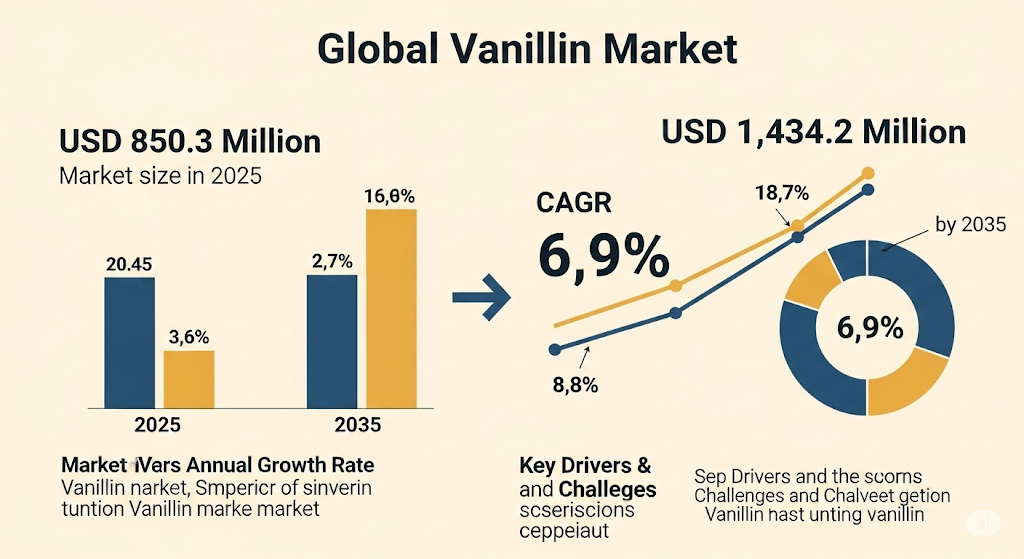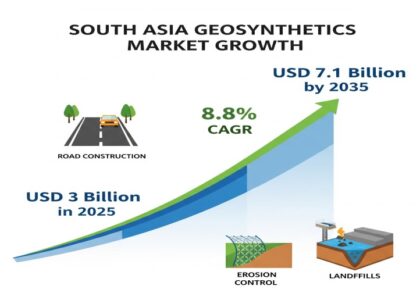
A Skyrocketing Market with a Hidden Cost
The global vanillin market is projected to balloon from USD 850.3 million in 2025 to USD 1.434 billion by 2035, growing at a solid CAGR of 6.9%, according to Future Market Insights (FMI). Synthetic vanillin dominates—accounting for 64.5% of the global market share in 2025, driven by its affordability, consistency, and scalable production.
But behind the commercial success lies a far more complex story: one of environmental trade-offs, regulatory ambiguity, and a growing disconnect between what consumers expect from “natural” flavorings and what the industry is willing—or able—to deliver.
Access Key Market Insights: Request a Sample Report Now:https://www.futuremarketinsights.com/reports/sample/rep-gb-483
The Petrochemical Dilemma
Most of the vanillin flooding global markets is derived from petrochemical-based feedstocks like guaiacol. This approach, while economically efficient, is neither clean nor sustainable. Synthetic production methods often involve energy-intensive processing, chemical solvents, and significant waste output.
FMI reports that despite growing demand for natural and bio-based alternatives, synthetic vanillin will continue to dominate due to its lower cost and established infrastructure. But that dominance is part of the problem: it reinforces the industry’s reliance on fossil fuels at a time when sustainability is more than just a marketing slogan—it’s a global imperative.
Soaring Demand for Market Information: Uncover Detailed Trends and Insights in Our Report: https://www.futuremarketinsights.com/reports/vanillin-market
Demand for Natural, But Supply Says Otherwise
Vanillin derived from natural sources—such as vanilla beans or biotechnological fermentation—remains a niche within the broader market. According to FMI, bean-extracted vanillin makes up a mere 1.3% of global supply. The vast majority of so-called “natural” vanillin is anything but.
This misalignment poses a credibility risk for brands and retailers. While consumers are increasingly drawn to clean-label products, many have no idea their favorite “natural” vanilla ice cream is likely flavored with synthetic or semi-synthetic vanillin.
The Untapped Potential of Bio-Based Vanillin
Future Market Insights notes that bio-based vanillin, derived through microbial or enzymatic processes, holds significant promise for both sustainability and product differentiation. Although still relatively expensive, this segment is poised for strong growth, especially as regulatory standards and consumer scrutiny increase.
Bio-based vanillin’s market share is expected to rise steadily over the next decade, driven by demand from premium food, beverage, and personal care brands seeking both environmental and labeling advantages.
Three Risks the Industry Can’t Ignore
- Environmental Backlash: As sustainability becomes a non-negotiable global standard, reliance on petrochemical feedstocks exposes companies to long-term reputational and regulatory risks.
- Consumer Distrust: The gulf between “natural” claims and actual ingredients risks eroding trust—especially in health-conscious and eco-minded segments.
- Innovation Bottleneck: Without accelerated investment in bio-based vanillin, the industry may miss its window to lead in sustainable flavor production.
Where the Market Must Go Next
- Accelerated R&D: Stakeholders must fund and scale bio-based solutions that align with climate goals.
- Clearer Labeling: Regulatory agencies and companies should move toward stricter definitions of “natural” to ensure transparency.
- Ethical Sourcing Mandates: Whether synthetic or natural, vanillin must be produced in ways that minimize harm to ecosystems and frontline labor communities.
Key players
- Advanced Biotech
- Tanobio
- Merck Group
- Camlin Fine Sciences Ltd
- Prinova Group LLC
- Merck Group
- Borregaard
- Aurochemicals
- Lesaffre
- Solvay SA
- Evolva
Conclusion: A Billion-Dollar Aroma at a Crossroads
Vanillin is more than a flavor compound—it’s a litmus test for how the food and fragrance industries adapt to a world demanding cleaner, more honest products. The market is growing fast, but so is the need for accountability.
If the future of vanillin continues to rest on outdated, petrochemical-heavy models, the industry risks spoiling more than just its sustainability record. It risks losing the trust of the very consumers who made this flavor the global icon it is today.
![]() Explore Functional Food Ingredients Industry Analysis: https://www.futuremarketinsights.com/industry-analysis/functional-food-ingredients
Explore Functional Food Ingredients Industry Analysis: https://www.futuremarketinsights.com/industry-analysis/functional-food-ingredients
Key Segments of Market Report
By Application:
By Application, the segment has been categorized into Food, Beverage, Pharmaceuticals, and Other Applications.
By Source:
Different Sources include Natural Vanillin and Synthetic Vanillin
By Form:
Different forms included Powder and Liquid
By Region:
Industry analysis has been carried out in key countries of North America, Latin America, Europe, East Asia, South Asia, Oceania, and the Middle East & Africa.





